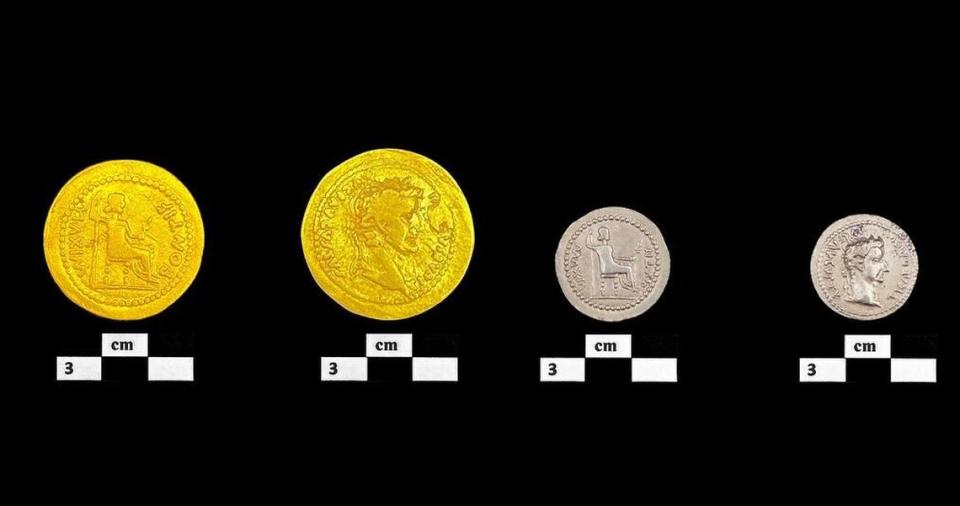Treasure-filled jar — possibly an offering — found in sand near 1,800-year-old ruins
About 1,800 years ago, someone in the United Arab Emirates filled a pottery jar with a collection of treasures: several gold Roman coins, some local bronze currency and a bronze bracelet. Then, they took the jar to a nearby religious building as an offering.
Or at least that’s what archaeologists who just rediscovered the jar during excavations at the Tell Abraq archaeological site in Umm al-Quwain hypothesize.
The team of archaeologists recently finished their 2023-2024 excavations of the sprawling, multi-period site, according to a Jan. 28 post from the Umm al-Quwain Department of Tourism and Archaeology.
The latest explorations of the ancient settlement — which dates to as early as about 2500 B.C. and was inhabited until about 300 A.D. — found a variety of ruins and artifacts, officials said. Among the most exciting finds were the gold coins, which were a first-of-their-kind for the area.
Here’s what archaeologists found at Tell Abraq.
A treasure-filled pottery jar and a fully preserved building
Archaeologists said one of their most important finds of the excavation was a fully preserved building dating to between the first and second centuries A.D.
The building contained a single square room, and it was associated with several other finds, including the “most astonishing” discovery of the season, Michele Degli Esposti, the excavation’s co-director, said in the video.
Within the building’s ruins, a pottery jar containing Roman coins, local coins and a bronze bracelet were found, Esposti said. The jar may have been a ritualistic offering, and the building could have been a cultic center.
Experts said it’s possible the Roman coins, known as “Uri,” were minted in France and were spread east through the extensive Roman trade network, according to a Jan. 24 post from the department. The gold coins bear depictions of Tiberius, who was the Roman emperor from 14 A.D. until 37 A.D.

The discovery marks a turning point in understanding the ancient site, indicating its important religious role and participation in trade networks.
Several stone statues, bronze figurines and clay figures were also associated with the buildings ruins, according to Esposti.
Additionally, an “outstanding” roughly worn stone with an fragmented inscription engraved on it was found in a rubble heap near the site, he said. Experts are working to translate the inscription, but it could be associated with religious practices.
A ‘remarkable’ metal figurine
Ruins of another ancient building, reduced to just a series of walls, were also discovered beneath years of built up sand, Ammar Albanna, who works for the department, said in the video.
Experts identified two construction phases of the building, according to Albanna. The first phase dates to the Iron Age, about 2,000 years ago. The second construction phase was later, indicated by different building techniques.
Within the ruins, archaeologists found a trove of artifacts.
Among their finds, experts found arrowheads, a knife, bronze coins and a “remarkable” metal figure which parallels finds from other Iron Age sites, Albanna said.
Three new graves from about 4,000 years ago
Archaeologists found three graves, dating to between the seventh century B.C. and the third century B.C.
One of the graves held two iron spears and two stone beads, according to Zoe Ceccato, an archaeologists on the project. Another held remains, including a finger with a ring on it.
Other graves had been found at the site during earlier excavations.
More ancient ruins
The remains of two other structures and a ditch equipped with an “outstanding” retaining wall were also found, archaeologists said in the video.
Within the first structure — a building described as a “unique monument” — experts found remains of a plaster floor and charred seeds, which dated to about the middle of the second millennium B.C.
The building has evidence of several architectural modifications, and archaeologists said the first changes were likely caused by a fire that caused damage shortly after the building’s initial construction.
The second structure dates to the Iron Age, around the first millenium B.C., experts said. Archaeologists uncovered plaster floor and several square-shaped structures that were likely used as bases for pillars or other removable features.
A deep ditch with a mud brick retaining wall was also found. Archaeologists said the bricks were covered with mud mortar and finger grooves left in the structure give insight into building techniques from the time.
The ditch was likely active between the end of the first and second millenia B.C., experts said.
Umm al-Quwain is in the northeastern United Arab Emirates.
Google Translate and Instagram were used to translate Instagram posts from the Umm al-Quwain Department of Tourism and Archaeology.
‘Unusual urn’ — still filled with 3,000-year-old human remains — found in burial mound
Massive 1,700-year-old tombs — loaded with high-end treasures — unearthed in China
Ancient settlement teeming with treasures was abandoned 1,900 years ago. See it now

